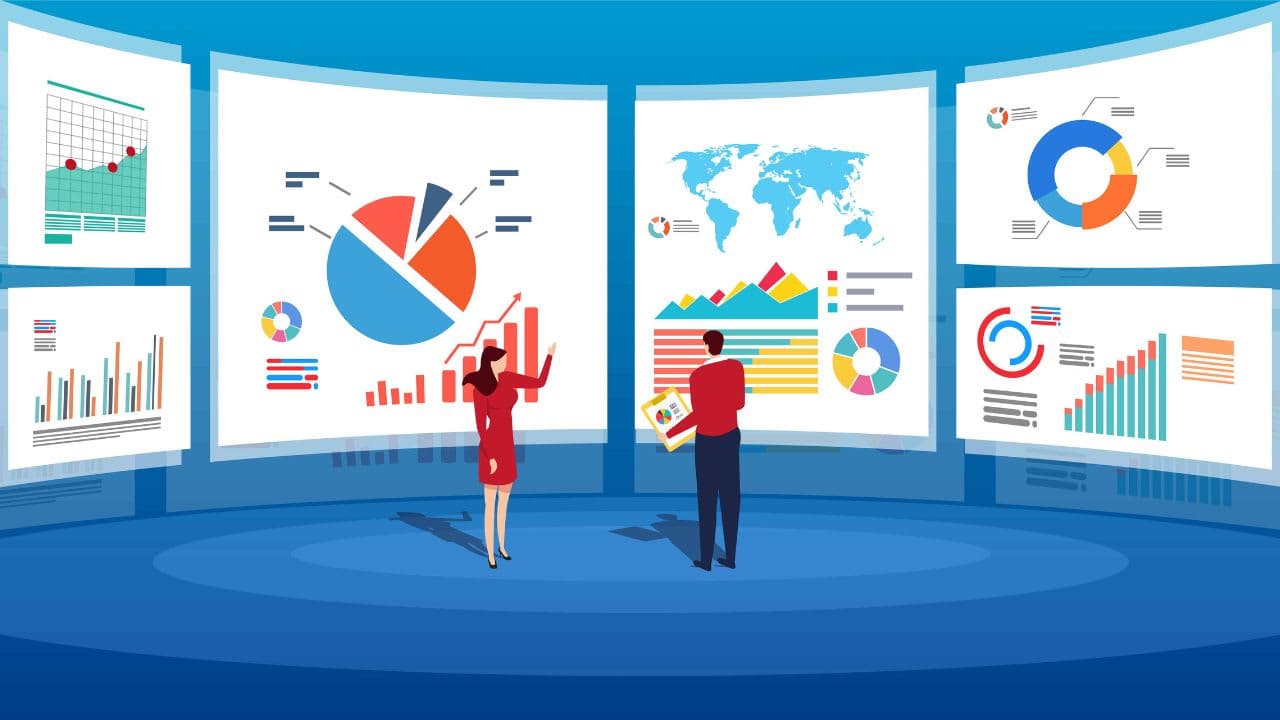11 Best Big Data Books in 2024 [Beginners and Advanced]
Big Data vs Small Data – What’s the Difference?
In today’s world, data plays a crucial role in various data-driven transformations and artificial intelligence strategies. Currently, there are two major data analysis approaches that can help organizations generate valuable insights: Big Data and Small Data.
Big Data refers to a high volume of structured, semi-structured, and unstructured data. While Small Data is about focusing on specific, smaller sets of data. Both these data can help in the decision-making process, improve customer experience, conduct in-depth analysis, and more.
These methods help organizations learn important things and stay ahead of the competition. In this article, we will be taking a closer look at Big Data vs Small Data in data analytics, Use cases, Differences, and much more.
What is Small Data?
Small Data can be expressed as data collection that is smaller in size for human comprehension. Basically, small data are datasets that are simple and straightforward enough in a format and small enough in volume can be processed by a single machine.
Small Data is excellent in providing valuable insights for businesses without having the need to implement any sort of system required for big data analytics. Some of the common examples of Small Data are Customer and product sales information, Information on customer behavior, Online shopping cart data, Purchasing information, and more.
There are three major characteristics of Small Data, which are as follows:
1. Accessible: Small Data comprises small volumes of data that are easily accessible and can be utilized without any complexity and difficulty.
2. Understandable: One of the best characteristics of Small Data is that it easily summarizes big data into small data forms that can be easily understood without any analytic programs or powerful algorithms.
3. Actionable: Small Data contains all the important data and insights regarding users and customers along with their behavior which can be helpful for making short-term decisions.
Small Data Use Cases
Small Data can provide beneficial insights, which can be applied to various practical scenarios. Here are some of the use cases of Small Data:
1. Customer Service: Small Data can help provide beneficial insights on customers which can help provide faster issue resolutions to businesses. This way businesses can help provide prior information on an issue such as “Fight Delay” to customers beforehand.
2. Expense management: Small Data can be utilized to provide a clear insight into the overall organization’s efficiency, which can be used to align your business activities and performance with your top priorities.
3. Local Retail store sales: Small Data can be utilized to track daily or weekly sales of your local store. It can also help keep track of how many customers entered the store, identify the number of goods across the store, and much more. This can help simplify the decision-making process such as restocking of goods, staffing, and sales promotion.
What is Big Data?
Big Data can be described as a huge chunk of data that is too large or complex to be dealt with by traditional data processing application software. Big Data contains a wide range of structured, semi-structured, and unstructured data. It is collected by companies and organizations for the usage of machine learning projects, predictive modeling, and various other analytics applications.
Big Data can’t be represented in a single machine and usually requires strong and powerful computing hardware, software, and algorithms to discover patterns, insights, trends, and more to help with operations.
Big Data is used by companies across the world to improve customer service by providing valuable insights on customers which can be utilized for refining their marketing, advertisements, and promotions.
Big Data Use Cases
Big Data can be extremely useful for providing valuable insights and patterns that can help grow across numerous fields. Here are some of the use cases of Big Data.
1. Banking, Financial Services, and Insurance
The BFSI is one of the most data-driven domains in the world economy. It consists of a huge amount of customer data such as information collected on customer profiles for KYC, withdrawals, deposits, and much more. The BFSI industry has been actively using Big Data to use these rich data sets and become more profitable and customer-centric. Various financial and banking institutes are utilizing the benefits of Big Data to improve levels of customer insight and help them gain a competitive advantage.
2. Manufacturing
Big Data plays a huge role in the manufacturing industry to outperform the competition. The Data in manufacturing is often collected through machines, operators, and devices at almost every stage of production, which results in a high amount of data getting stored. Big Data helps manufacturers store and manage these data efficiently. Manufacturers also utilize big data to identify new methods of saving costs and solving existing problems. Apart from this it also helps find ways to improve product quality.
3. Healthcare
Big Data is making a huge impact on the healthcare industry thanks to its wearable devices and sensors. These devices can help collect patient data which can be further fed in real-time to individuals’ electronic health records. Big Data’s predictive analytics can be helpful for predicting epidemic outbreaks, prevention of serious medical conditions, and much more. Apart from this, Big Data can also provide Real-time altering, Research acceleration, Enhanced analysis of medical images, and more.
What are the three differences between Big Data and Small Data?
Here are three differences between Big Data and Small Data:
1. Big Data vs Small Data: Volume
Big Data contains a huge volume of data and information and is usually in the order of terabytes or petabytes. Big Data includes processing and analyzing large datasets that can’t really be handled with traditional data processing methods.
Meanwhile, Small Data contains relatively smaller data sizes, which are often in the form of gigabytes or anything lower. Small data includes working with datasets that can be handled using software or standard hardware that doesn’t require any complicated infrastructure.
In addition, Big Data is stored in a data lake as it requires large storage spaces to store and manage these high volumes of data. Meanwhile, File systems or databases are where small data is stored.
2. Big Data vs Small Data: Velocity
Big Data is collected and processed at a faster pace with high data velocity. It typically requires real-time data ingestion and processing. It also includes handling streams of datasets that are generated at a faster speed, such as social media feeds or sensor data.
On the other hand, Small Data is often characterized by low data velocity, which means it generates data at a slower pace compared to Big Data. Usually, it doesn’t require real-time data processing and is often analyzed in periodic intervals or batches.
3. Big Data vs Small Data: Variety
There are three types of data encompassed by Big Data: Structured, Semi-Structured, and Unstructured data. Big Data is involved in gathering information from numerous sources such as Text documents, Social media platforms, Images, Videos, and much more.
Small Data only consists of “Structured Data” which is generated with well-defined formats. It often originates using specific databases or sources and is involved in a consistent structure.
Real-Life Examples Big Data vs Small Data
Both Big Data and Small Data can help provide beneficial insights that can be applied to numerous sequences of events. Here are big data vs small data examples:
1. Social Media Analytics: Big Data can help analyze massive volumes of posts, comments, and interactions from various social media platforms and process those data to create a better understanding of current trends, customer behavior, preferences, and much more.
2. E-commerce Personalization: Online retailers such as Amazon utilize Big Data to understand and analyze their consumers’ browsing patterns, preferences, purchase history, and demographic data to personalize product recommendations. This can also help improve customer experience on the platform by processing large datasets which might result in increased sales.
3. Entertainment and Streaming services: Top companies such as Netflix and Spotify use Big Data to identify the viewer count and habits of their consumers. The collected data is later used to suggest content and generate a personalized playlist.
4. Patient RecordsSmall data can be utilized in the healthcare industry for keeping track of individuals’ patients’ history. This usually includes patients’ medications, treatments, and diagnoses. This helps the doctor make personalized and informed decisions about the healthcare of the individual patient.
5. Classroom Data: Teachers can also use small data analytics to keep a performance track of individual students in the classroom. This can help teachers identify the performance level of individual students and keep track of students who are struggling and require additional support.
6. Customer Feedback: Small data can be useful for generating customer feedback for relatively small businesses such as local restaurants. The owner can collect feedback from their customer to understand the preferences of their customer and identify areas that require changes based on users’ responses.
Why is Small Data better than Big Data?
Small Data is easier to understand and process without any complexity and difficulty compared to Big Data. Small Data is also enabling smaller enterprises to get involved in this data-driven world. The reason why Small Data is considered better than Big Data is due to security risks associated with Big Data, which makes it less preferable.
When dealing with large amounts of data, it’s crucial to have powerful security to protect your data from hackers to avoid any misuse of data. This can be extremely difficult for some organizations, as new data gets stored every day which can make it difficult to store and manage data at such high volume.
The Traditional databases utilized for small data purposes are not designed for any large volume of data. Big Databases tend to focus more on the flexibility and performance of the data over security. Due to this most people tend to consider Small Data better than Big Data.
What is the difference between Big Data and Small Data in healthcare?
Big Data in healthcare refers to the huge chunk of data collected to provide useful insights from various sources such as electronic health records, medical imaging, genomic data, wearable devices, and more.
Meanwhile, Small data in healthcare often works towards understanding specific cases, in-depth analysis, and focusing on getting insights on particular cases. Although Big Data has been huge in healthcare in the past few years, clinicians seem to be moving towards small data analytics to efficiently manage patient care.
Small data can be useful in providing big insights for individuals. It can be beneficial in providing quick input on allergies, missed appointments, times for blood cultures, and more. In healthcare ISVs, the challenge is to connect Small data to big data which can help provide individual healthcare for patients.
![11 Best Big Data Books in 2024 [Beginners and Advanced]](/_next/image/?url=https%3A%2F%2Fres.cloudinary.com%2Fdvzkzccvn%2Fimages%2Ff_auto%2Cq_auto%2Fv1697123039%2F11-Best-Big-Data-Books-in-2023-Beginners-and-Advanced-1%2F11-Best-Big-Data-Books-in-2023-Beginners-and-Advanced-1.jpg%3F_i%3DAA&w=3840&q=75)

